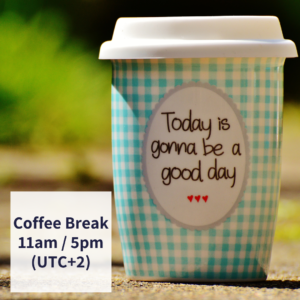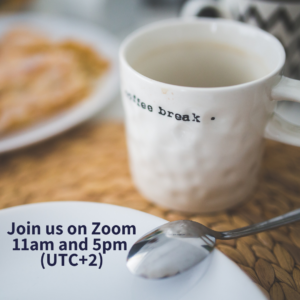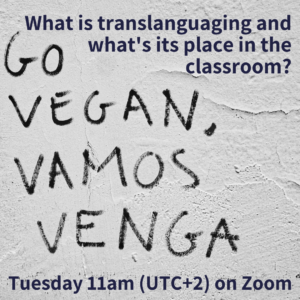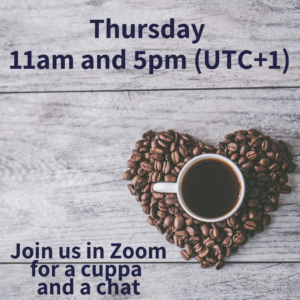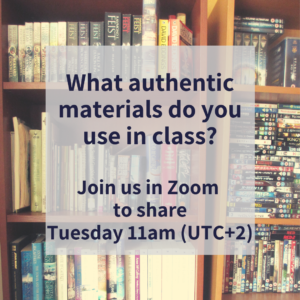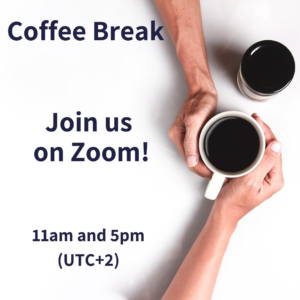We opened up talking about pubs opening up in Ireland (only outside), haircuts being possible again in Germany, Mercury in retrograde and grandmothers sucking eggs! We compared each other’s tech setups; new mics, lighting, standing up work spaces, etc. We talked about the odd reality that is that of the travelling examiner, a tour of 7 weeks, staying in hotels and feeling a wee bit uncomfortable. We mused on cultural shifts around the increased popularity of Santa (vs the 3 Kings) at Christmas and wondered whether the tooth fairy does really exist?!
Interestingly both sessions went down similar lines… In one “Is it our duty to raise awareness and open students’ eyes with regards to social matters, or is it just not our place to do that?” and in the other “Are there “taboo” subjects or should education be open?” There are strong and often conflicting, always complex, opinions. The Hub is a great place to explore these subjects; it’s a safe, open space where all are respected. These notes are an attempt to bring together the two conversations…
English teacher or “educator”?
We asked ourselves if our role is to teach English or to “educate” people and then whether we’re qualified to do so. It’s also a linguistic question rather than just a moral one; we should include vocabulary like “life-partner”, of course.
Some felt that they really wanted to address some of these issues to “make the world a better place” and others very much thought it wasn’t our job to do that. We noted that we spend a great deal of energy making students feel comfortable in class so we need to think carefully.
What do we do when we hear “rude” or “inappropriate” comments? I want to talk about my views, should I?
We need to teach people how to not offend people, we never know who might be thinking, feeling or experiencing what in our classes.
Perhaps our job is to support students to ask and answer difficult questions, especially if it comes from the students or comes up in class, as well as create the environment where our students feel comfortable. We need to provide the vocabulary and create a culture of respect.
Our job is not to guide students rather than impose anything, unless there is something offensive to deal with (and then it’s up to our discretion). Having said that, when we encourage critical thinking and critical reading and whenever we introduce a text or an idea, we’re sort of imposing an idea. Also, if there are only straight people portrayed, we are imposing “a straight-washed world view”. We also acknowledged the sanitised world view that coursebooks so often portray, do often aspirational, middle class, white, and can be seen in the vocabulary in books (e.g. jobs).
Representation is the first step
We don’t need to talk about the issues, images can begin the process. Representation is the first step.
Can we use LGBTQ+ pictures in our primary classes? Why not? It’s a representation of society. We wondered whether ELT is, due to issues around international acceptability, behind the curve in many ways. We talked about using different photos of families, for example, including one from “Modern Families” (containing all sorts of families!). There are increasingly representations all over the place, why not in ELT? Might parents complain? How might language schools react? Arguably, schools should support their teachers with parents and in CPD. There is much work to do. We wondered whether students sign up for language and/or culture? Inclusivity is increasingly part of international culture, it is only natural for it to be included in our classes too.
We can create space for the conversations to happen and this will, of course, differ in different contexts, for example, in Brazil these conversations feel more commonplace than in Spain. Is that because the society is more conservative as a whole or because of the dominance of religious education among our students or is it because of our students… or maybe us? In Korea there was a race awareness element of a British Council programme which included a variety of reactions to mixed race marriages and led to significant difficulties for the students. We need to be sensitive. We might well need to balance the global with the local reality. At the same time we need to remember that students lives are not limited to the local, many of our students exist within international spaces online.
If materials don’t exist, we can create our own. One participant talked about the freedom they have in teaching (a group of adults) without a coursebook and using an article about Sam Smith choosing the “they/them” pronoun. Their context is international Geneva where people are used to being asked their opinion about everything in frequent referenda. We talked about the importance of the conversations being student-driven.
We don’t need to bring the text in, our students can (they might bring in texts that contain sensitive stuff). Ideas around student voice and choice can be extremely powerful in class as they have control to really contribute.
The teacher might need to guide (and almost certainly provide a model) and then students can drive things forward. One difficulty we might encounter is that students can worry if we ask totally open questions, instead we can give a choice of three ideas with a “or anything else you’d like to choose”.
One idea was a reading activity where students bring in texts, put them around the walls and have two minutes to read each one before taking two more minutes to write notes on what they’ve just read before moving on to the next one. After the texts have all been read and notes taken there are a whole range of possible activities afterwards (writing comprehension check questions, creating exam style cloze activities, writing discussion questions, etc…)
Another practical idea was around giving presentations, again we need to provide a model and give support. We commented that this felt like a TBL (task based learning) approach where the students look at a model, complete a task and then produce the product.
We talked about the potential difficulty of presenting “controversial statements” to the class which they have to agree or disagree with.
We agreed that it’s easier to talk about other people rather than to “own” it all.
Representing everybody is normalising. Everyone should be represented. Representation is the first step.
Is our own awareness already “out-dated”?
We thought, yes, it’s quite likely, things are changing fast and it can be hard to keep up with it all. The best we can do is be aware and realise that we might “get it wrong”.
13 Reasons Why (a text about suicide) was used as a set text by an exam board and appropriacy was again questioned. Teenagers arguably need and want to talk about these issues. Are we prepared? Instead of us providing the answers we need to find out how to guide them to access the support they need.
What is our personal mission as teachers?
We often talk about the mission of a business but what’s our own mission, why are we teaching? Teaching can be a radical tool of transformation; education can be the way up and out of a particular situation. A teacher can be a “motivator”, to communicate in a different language can be a joy and we can open doors to understanding the world.
TEFL influencers… is that a thing?
We went on to talk about FOMO (Fear of missing out) and JOMO (the Joy of missing out) for our teenage students. They read a lot of influencers rather than listening to teachers or parents. We wondered whether there are TEFL influencers…
